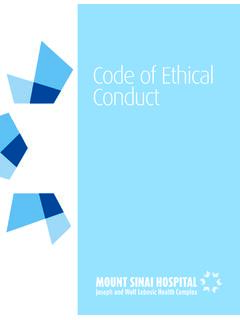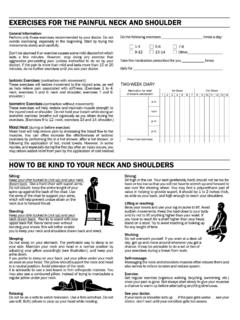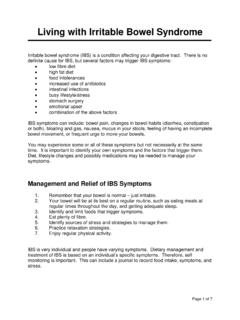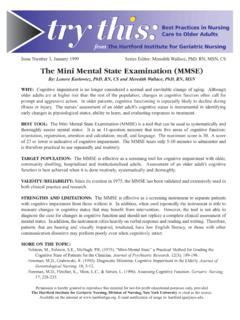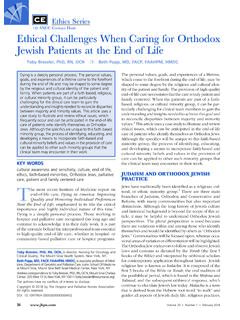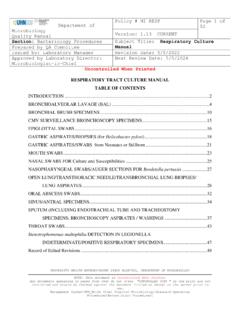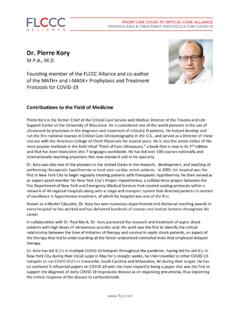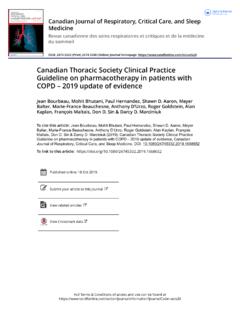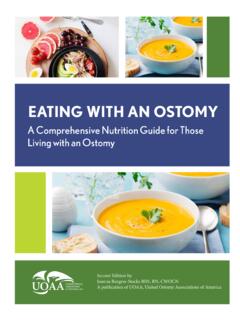Transcription of Dental Management of Patients with ... - Mount Sinai …
1 Dental Management of Patients with Renal Failure By: Sina Moshiri Classification of Renal Failure The kidney compensates for the loss of a nephron through hypertrophy of the remaining nephrons. Thus, kidney function is maintained until roughly 50% of functional nephrons have been lost. Symptoms of renal impairment begin to emerge once this point is reached. Acute renal failure (ARF) is characterized by a sudden, significant reduction in glomerular filtration rate (GFR). ARF may be a result of pre-renal, intrinsically renal or post-renal causes. Patients with ARF are typically not suitable for elective Dental care. Chronic renal failure (CRF) is characterized by a progressive loss of functional nephrons and reduction in GFR. The natural end-point of CRF is end-stage renal failure (ESRF), which can only be managed with dialysis and/or kidney transplantation.
2 Table 1 Acute renal failure Chronic renal failure Pre-renal Intrinsic renal causes Post-renal gastrointestinal losses excessive perspiration bleeding burns w/ fluid sequestration renal losses cardiovascular failure liver failure acute tubular necrosis (vasomotor nephropathy) severe cortical necrosis severe acute glomerulonephritis vasculitis malignant HTN accelerated scleroderma allergic interstitial nephritis ureteral obstruction bladder obstruction bladder rupture urethral obstruction chronic immune glomerulopathy HTN nephrosclerosis chronic tubulointerstitial diseases metabolic disease congenital/hereditary renal processes Chronic Renal Failure CRF is diagnosed on the findings of GFR <60 mL/min, renal damage (albuminuria), hematuria and radiologic anomalies during a period greater than three months.
3 Epidemiology CRF typically increase with age, affects men more than women, shows higher incidence in Asians and Native Americans and is frequently secondary to diabetes mellitus (40-60%), arterial hypertension (15-30%), and glomerulonephritis (10%). Diagnosis Renal function is inferred by assessing changes in GFR using the following methods: o insulin clearance (not widely used in practice) o creatinine clearance (common method but overestimates GFR) o precise 24-hour urine samples (laborious) o formula using serum creatinine levels (factoring in age, sex, race) 2 Table 2 shows how GFR may be estimated based on plasma creatinine and clinical context Table 2 Glomerular function % filtrate Creatinine clearance Blood creatinine Clinical condition 100% 90-120 mL/min mg/dL Normal >50% >45-60 mL/min < mg/dl Renal compensation 25-50% 20-60 mL/min Onset of clinical mg/dl features of renal failure (hematuria, fatigue) 10-25% 10-25 mL/min mg/dl Established clinical disease <10% <10 mL/min > 10 mg/dl Dialysis Early vs Late CRF o GFR is a useful late stage marker of kidney disease.
4 Early stage CRF may exhibit normal or only slightly reduced GFR and thus may mask the disease o As such a more useful early marker of CRF is proteinuria. Albumin (predominant protein excreted by kidneys) can be detected by reactive strip test or by other precise means Clinical Manifestations General clinical features depend on underlying systemic or renal issue and rate of renal function impairment Arterial hypertension common complication, resulting from retention of sodium and water, and activation of RAAS (renin-angiotensin-aldosterone system) Uremia presents as generalized paleness (secondary to anemia), brown hyper- pigmented nails and skin (secondary to retention of dietary pigments) and intense itching (secondary to build-up of calcium and phosphate microcrystals) Anemia secondary to impaired erythropoiesis Hemostatic impairment altered due to platelet dysfunction and anti-coagulant use in dialysis Platelet dysfunction increased risk of bleeding due to.
5 Diminished platelet count due to mechanical trauma from dialysis reduced platelet adhesion due to increased prostacyclin activity, decreased platelet factor, and decreased capillary strength Immunosuppression uremia results in decreased cellular immune function and impaired chemotaxis Renal osteodystrophy impaired mineral metabolism, increasing risk of fractures, bone defects, pain and calcifications 3 Endocrine dysfunction increased risk of hypoparathyroidism, delayed growth, infertility (women) and erectile dysfunction Oral approximately 90% of CRF Patients experience oral manifestations Uremia bad odor, metallic taste Xerostomia due to reduced fluid intake, polypharmacy, salivary gland dysfunction and sleep apnea. Pallor paleness of mucous membranes Uremic stomatitis uncommon finding related to uremia painful bleeding, hyperkeratotic ventral tongue, buccal mucosa Bleeding gingival bleeding, petechiae, ecchymosis resulting from platelet dysfunction Gingival hyperplasia secondary to use of cyclosporine, calcium channel blockers Erosion erosion of lingual surfaces due to frequent vomiting and nausea Periodontal disease Pulp obliteration, enamel hypoplasia Delayed Dental eruption related to altered calcium and phosphate metabolism Altered bone composition renal osteodystrophy resulting in decreased trabeculation, loss of cortication, giant cell radiolucencies and soft tissue calcifications increased fracture risk during extractions Caries decreased due to bacteriostatic effect of urea Infections candidiasis.
6 Cytomegalovirus following transplantation Mucosal lesions lichenoid lesions, oral hairy leukoplakia secondary to immunosuppression Malignization potential increase risk of epithelial dysplasia and carcinoma following renal transplantation. Immunosuppression predisposes mucosa to viral tumors such as Kaposi s sarcoma or non-Hodgkin lymphoma. treatment & Prognosis Conservative Management aims to: prevent or correct metabolic changes and preserve remaining renal function. treatment options include a high carbohydrate, low protein diet (consensus lacking), body weight control, antihypertensive medication, lipid lowering agents, vitamin D, erythropoietin therapy 4 Surgical Management is only considered once conservative Management fails. Management includes renal transplant or dialysis. Dialysis is the mechanical removal of excess water and metabolites from the blood in the context of kidney failure.
7 Peritoneal dialysis involves placement of a catheter into peritoneum of abdomen. Filtration takes place via osmotic flow. Hemodialysis (HD) involves a dialyzer, which carries blood through a semipermeable membrane and filters out toxins and metabolites. Usually performed three days a week, which requires a permanent vascular access in the form of a catheter or arteriovenous fistula. HD Patients receive anticoagulants such as heparin to ensure a permeable vascular access and constant blood flow through the dialyzer. Renal transplantation is indicated in Patients with irreversible renal failure. Patients receive immunosuppressive therapy before and after surgery to prevent rejection. This persists for life unless the organ was donated by an identical twin. Infections remain the second leading cause of mortality in CRF.
8 Vaccinations and careful monitoring are critical to prevent establishment of infection Life expectancy of dialysis Patients are 1/3 of the general population. Commonest cause of death related to ESRF include cardiovascular issues, infections, and malignization. Dental Management of Renal Failure Patients General modifications: o Multidisciplinary approach to health care involving creation of Dental plan in context of Patients overall medical status o Consultation with patient s nephrologist to determine the state of the disease, treatment being received, ideal timing for Dental treatment , and possible medical complications that may arise. Proposed changes to Patients medications or treatment timing must discussed with the nephrologist. o Prior to invasive Dental treatment must obtained complete blood count and/or coagulation tests to identify any alterations o Prompt elimination of sources of infection or oral trauma o Consideration for antibiotic prophylaxis when treatment involves bleeding or risk of septicemia (extractions, periodontal therapy, endodontics, periapical surgery, orthodontic braces, implant surgery, reimplantation).
9 O Continuous cardiac monitoring in combination to stress reduction methods (sedation) o Dose adjustment of drugs whose pharmacokinetics are altered in context of renal failure Pharmacologic modifications (Table 3) o Avoid aminoglycosides, tetracycline s due to nephrotoxicity o Usual doses of penicillin, clindamycin, cephalosporin s may be administered but at a prolonged dosing interval o Acetaminophen remains analgesic of choice. Due to the prolonged antiplatelet activity, aspirin should be avoided in Patients with uremia. NSAIDs require dose reduction or complete avoidance in advanced renal failure as they impart a hypertensive effect o Benzodiazepines do not require dose adjustments, however excessive sedation may occur o Medications primarily metabolized by the liver, including narcotics (codeine, morphine, fentanyl) do no not require dose adjustment 5 Modifications for dialysis Patients o Peritoneal dialysis Patients require no special modifications beyond the general precautions listed above o Hemodialysis Patients should receive Dental care on non-dialysis days in order to prevent excess bleeding.
10 Heparin which has a half-life of four hours, must be eliminated from circulation prior to treatment . Invasive treatment should be preceded by complete blood count and coagulation tests. Local hemostatic measures must be available, including mechanical compression, sutures, topical thrombin, microfibrillar collagen and oxidized cellulose. Additional hemostatic measures may include desmopressin for severe bleeding renal failure Patients , conjugated estrogens, and tranexamic acid rinse or oral tablet (10-15 mg/kg/day). o Antibiotic prophylaxis remains controversial for these Patients . In general, Patients with central lines may receive antibiotics one hour prior to Dental treatment to prevent bacterial endocarditis. Transplant Patients o Elective Dental care should be avoided within the first 6 months after transplantation o All sources of infection and hopeless teeth must be extraction prior to transplantation o Risk of oral infection after transplantation is very high due to concurrent immunosuppressive therapy.
